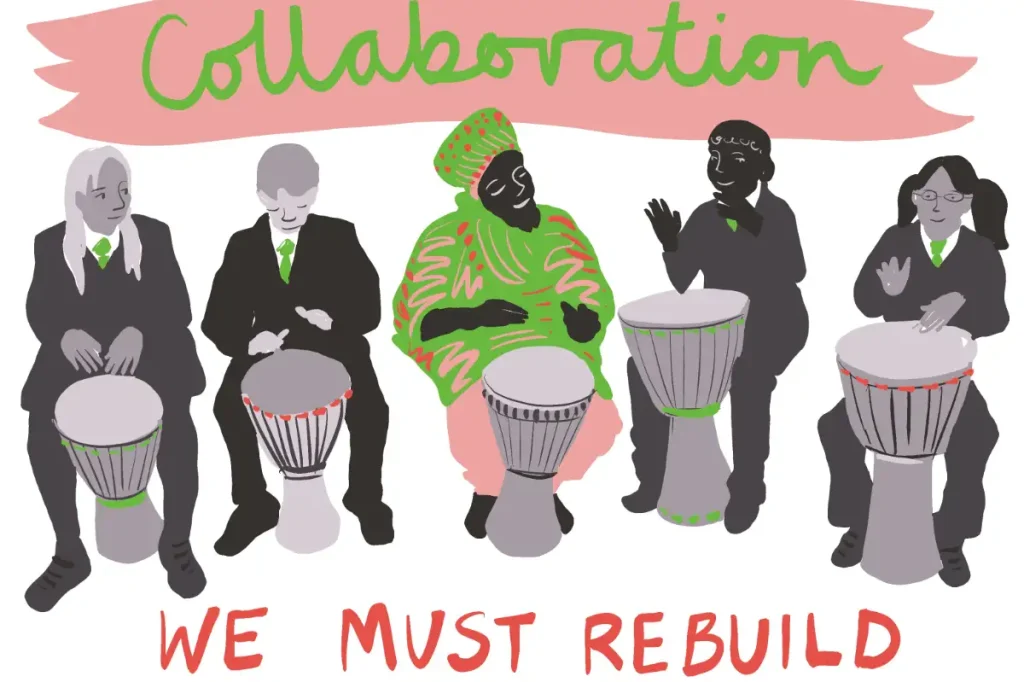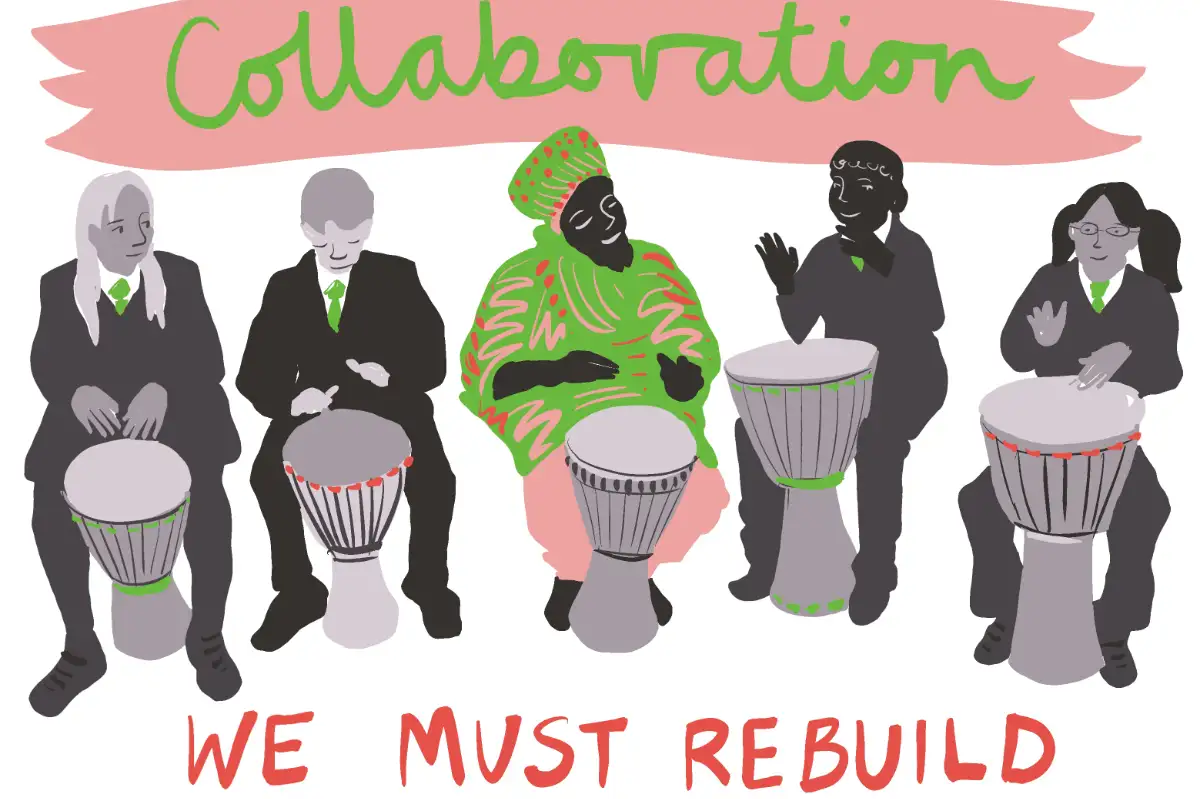Sally Bacon reflects on the relationship between schools & the arts sector over the last 40 years
We published The Arts in Schools: a new conversation on the value of the arts in and beyond schools in May 2022, reflecting on the 1982 Gulbenkian report on this topic, and developments in arts education since.
In June and July 2022 we convened a series of roundtables on Zoom with school leaders, teachers, arts education practitioners, academics and policy makers on eight themes in the original report. What follows are personal reflections following what was discussed in a meeting chaired by Jacqui O’Hanlon MBE on the role of arts organisations and artists. A fuller response to what we heard across all the roundtables and responses to our Think Piece will be published in a new report in early 2023.

In 1982 The Arts in Schools described the need to foster contact between the world of ‘professional arts’ and that of education, outlining the mutual benefits, giving examples, and examining the barriers. This contact was seen as being ‘of prime importance to the future development of both the arts and of education’. An Arts Council publication on Professional Arts and Schools (1980) had sought to describe the range of existing work, but there was no sense of this being a comprehensive survey, or of ‘contact’ being universal. The Arts in Schools was concerned with establishing the principles of such work, and setting out a course of action for furthering delivery. Among the main areas of activity it described were artists in education schemes, dedicated arts education companies, and arts education liaison schemes organised by professional arts organisations. It concluded that exposure is vital: ‘Behind these schemes we see a broader educational principle – that of opening the school itself to new influences and of seeing education in a much wider setting than schools alone.’
Those involved in the report would be astonished by the scale of the contact between schools and the professional arts sector today. Over the past forty years there have been huge gains in terms of workforce expansion and the professionalisation of the sector – kickstarted by the Gulbenkian report. It would be unusual now for a cultural organisation not to have a learning team in post in some form, providing an entry point for schools and for artists. And there has been an enhanced recognition post-pandemic of the vital role of freelance artists – estimated to form a huge proportion of the arts education workforce.
But the gains of the last forty years, and the growth in the sector’s responsiveness to schools, are not universal or permanent. Whilst huge progress has been made, provision is patchy and vulnerable. For some organisations Covid-enforced closure brought a new focus on hyper-local community engagement for those who needed it most. In many cases there was also significantly increased access to schools through digital reach and new hybrid ways of working. But the pandemic has also brought a new vulnerability. Organisational structures which value and prioritise the learning and participation function are placed under pressure at time of financial crisis and retrenchment (1). A dissonance can emerge within organisations between declared values and actual resourcing, and with the additional pressures of escalating energy costs there is now a very real sense of the fragility of the arts learning infrastructure and resource.
Working as a funder of cultural learning for many years I learnt to request staff organograms with applications, given the clarity with which they revealed the values, priorities and DNA of an organisation. Is learning represented on the Senior Leadership Team? Are titles used to confer departmental status (manager/head of/director)? How is the learning and participation team structured and resourced? Is it core funded or supported by project funding, meaning that posts will be vulnerable when that funding (usually short-term) ceases? Does the individual heading up the learning function have the skills and experience necessary for the role, and is there a lead position dedicated to learning or is it just one strand of a wider brief? Is there a lead trustee for learning and are they qualified for that role? The answers to these questions, combined with budget allocations, present a deeper picture of the real value an organisation attaches to learning and participation work; is there an actual or theoretical recognition of learning as a core, integrated purpose?
The confidence of professional practice, and the role of artists and arts educators, are well established today, but cannot be taken for granted; they need to be integrated, supported and valued if the sector is to provide young people with the continued connection they need. Our consultation stressed the importance of the Arts Council centering this work, and revealed the value of continued professional development for arts educators and artists, together with time for dialogue and evaluation. The delivery infrastructure is not only provided by learning teams within individual cultural organisations, and the artist educators they employ, but in building capacity for brokerage within the system. Whether provided by Bridge organisations, Local Community Education Partnerships, or other agencies, this work is vital in supporting partnership and collaboration, and in building communities of practice. One consultation colleague asked whether what is really needed is a national college of practice.
Schools require clearly articulated and sustained offers, linked to curriculum work, and people to facilitate them. It can take time to build relationships and trust in the face of multiple pressures and agendas within schools, and supporting the upskilling of teachers is important. Understanding the post-pandemic operating context of schools is critical: performance targets squeezing the arts to the margins; their reduced capacity to work with cultural organisations; the growing mental health crisis; and escalating financial pressures.
Telling stories about the impact of working with cultural organisations and artists on schools, and on young people’s lives, is crucial, and forty years on we have a new wealth and diversity of evidence to draw upon.
Schools and cultural organisations are both part of their communities, and relationships between them, and with artists, are essential to ensure arts access for children who would not otherwise access the arts through their families. As we navigate all the competing pressures for schools and the cultural sector, it is important to remember that children’s access to the arts is a social justice issue. Placing their needs at the heart of what we do now is essential if every child is to have access to arts and culture, and to the evidenced benefits that brings.
- The Museum Association Redundancy Tracker in 2020 cited Learning and engagement as the area of employment most likely to have been affected by redundancy during Covid.
We will be sharing a new The arts in schools: foundations for the future report in the new year. Subscribe to our newsletter to stay up to date, and get involved in the conversation on social media using the #ArtsinSchools hashtag.




